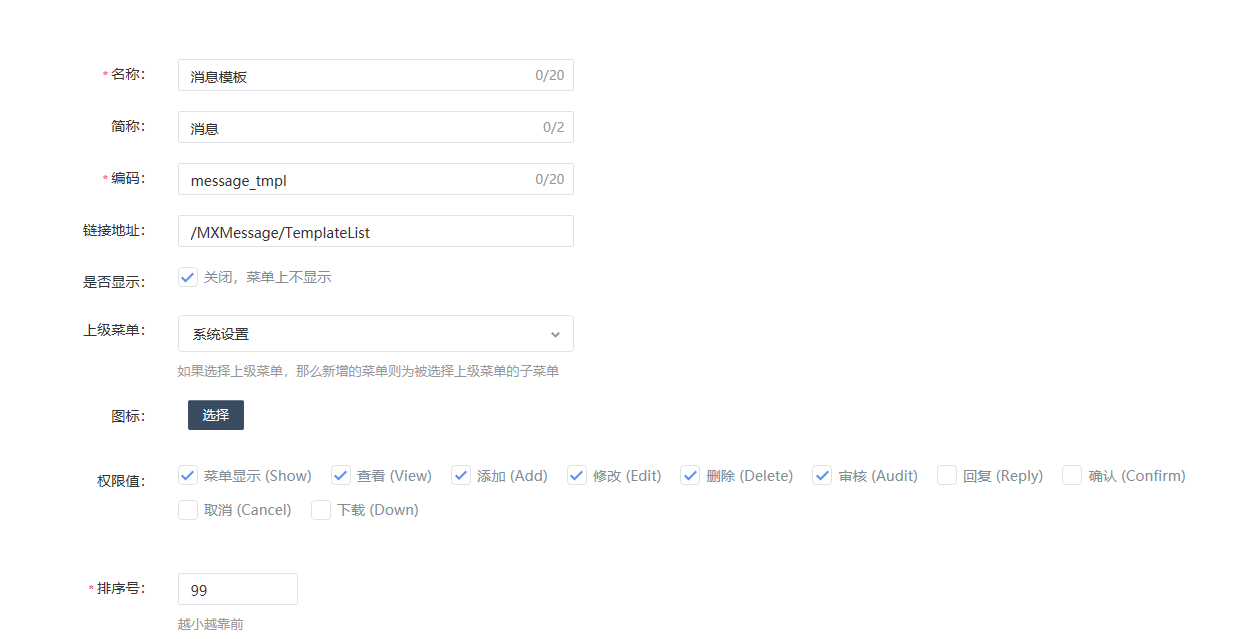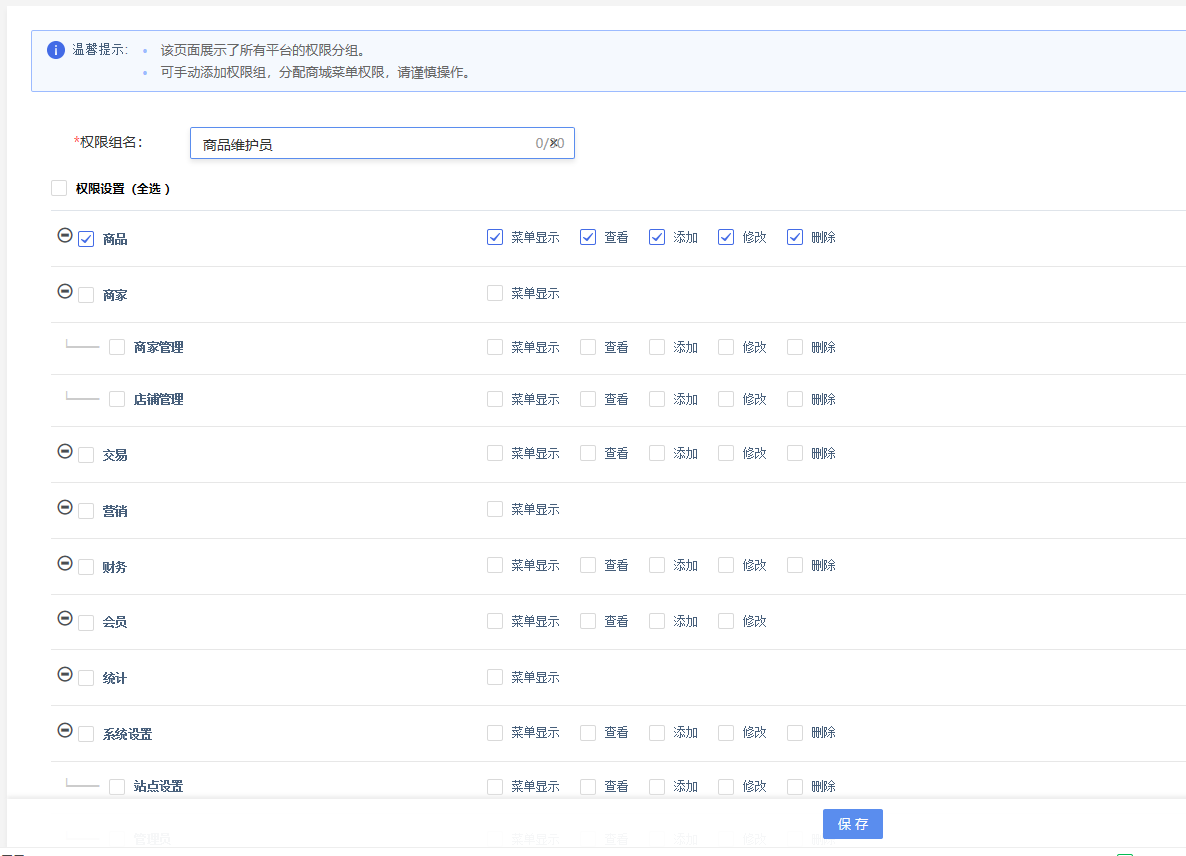asp.net Core3.1自定义权限体系-菜单和操作按钮权限
我们在做项目项目,经常会碰到权限体系,权限体系属于系统架构的一个最底层的功能,也是非常重要的功能,几乎在每个项目都会用到。那么我们该如何设计一个比较合理的且扩展性较强的权限体系呢?
经过多天的摸索,参考多个系统以及自己的经验,《沐雪微店系统 NetCore3.1》的权限体系是这样的。
- 一、首先确定几个重要实体的关系:用户,角色,权限;这三者之间的关系如下:

其中:
1、用户与角色是1对多关系( 1个用户只有1个角色,1个角色可以对应多个用户);
2、角色与权限组是1对1关系( 1个角色只有1个权限组,1个权限组只有1个角色)。
3、一个权限组里包含1个菜单和多个操作按钮;
4、操作按钮预先定义好最多的情况的枚举值;(比如 查看,新增,修改,删除,审核,下载,确认,回复)
这样的架构,相对来说比较合理,适合绝大多数系统使用了。(设计的越灵活,控制起来越困难,越困难越容易出现错误,所以要根据实际的情况控制灵活到什么程度即可;不要一口吃成胖子,想要一次性搞出无限灵活的权限系统。)
- 二、对几个实体进行CRUD单实体操作(增,删,改,查)
1、菜单的增删改查;

2、权限组的增删改查:

3、用户的增删改查:

- 三、用代码来实现权限系统
大家在菜单管理页面,应该注意到有3个字段:--编码,链接地址和权限值;这些是我们写代码的时候需要用的。
1、创建一个控制器的父类--BaseController,这里只要有一个可以获取当前登录者的方法即可,类似如下代码:


/// <summary>
/// 当前登录者
/// </summary>
public PTLoginResp CurrentUser
{
get
{
PTLoginResp currentUser = new PTLoginResp();
if (User.Identity.IsAuthenticated)
{
var claimIdentity = (ClaimsIdentity)User.Identity;
string key = claimIdentity.FindFirst("tokenid").Value;
currentUser.id = LoginCredentials.PFDecodeRedisKeyOfUserId(key); currentUser.user_name = claimIdentity.FindFirst("user_name").Value;
currentUser.real_name = claimIdentity.FindFirst("real_name").Value;
currentUser.mobile_phone = claimIdentity.FindFirst("mobile_phone").Value;
currentUser.role_id = ConvertHelper.LongParse(claimIdentity.FindFirst("role_id").Value, ); }
return currentUser;
}
}
2、创建具体的业务控制器和相应的Action,并且集成BaseController;
3、创建一个Action的权限属性特性方法,比如下面代码:
/// <summary>
/// Action的权限属性
/// </summary>
[AttributeUsage(AttributeTargets.Method | AttributeTargets.Class)]
public class ActionAuthDescriptorAttribute : System.Attribute
{ public ActionAuthDescriptorAttribute(string NavCode, AuthTypeEnum AuthType)
{
this.NavCode = NavCode;
this.AuthType = AuthType; }
/// <summary>
/// 权限组code
/// </summary>
public string NavCode { get; set; } /// <summary>
/// 权限操作的枚举值,比如Show
/// </summary>
public AuthTypeEnum AuthType { get; set; } }
这样,我们就可以在Action上加上这个特性了:
/// <summary>
/// 《沐雪微店系统 Netcore 3.1》添加管理员页面
/// </summary>
/// <returns></returns>
[ActionAuthDescriptor("manager_mgr", AuthTypeEnum.Add)]
public async Task< ActionResult> Create()
{
ManagerInfo managerAdd = new ManagerInfo();
managerAdd.using_type = UsingTypeEnum.sys.ToString();
managerAdd.is_lock = false; List<muxue_role> roleList =await _roleService.GetRoleList(UsingTypeEnum.sys);
roleList = roleList.FindAll(p => p.is_sys == false);
ViewBag.roleList = roleList; return View(managerAdd);
}
4、开始写权限验证过滤器了PrivilegeFilter:
验证的大概逻辑如下:
/// <summary>
/// 《沐雪微店系统 Netcore 3.1》权限验证逻辑
/// (集成BaseController的控制器,需要登录后才可以)
/// 1、看下Controller是否有AllRightsAttribute;
/// 2、看下Action是否有AllRightsAttribute,是否有ActionAuthDescriptorAttribute
/// 3、(1)若Action有AllRightsAttribute,则说明任何登录者都可以访问;
/// (2)若Action没有AllRightsAttribute,但是Controller上有,则说明任何登录者都可以访问;
/// (3)若Action和Controller都没有,并且Aciton也没有ActionAuthDescriptorAttribute, 则任何人都不可以访问;
/// 4、看下Action是否有ActionAuthDescriptorAttribute,则任何人都不可以访问;
/// 5、若有ActionAuthDescriptorAttribute,则进行判断该Action是否有该角色的权限;
/// </summary>
/// <param name="context"></param>
重点的代码如下:
public override void OnActionExecuting(ActionExecutingContext context)
{ var controller = context.Controller as BaseController;
if (controller == null)
{
base.OnActionExecuting(context);
return;
} if (controller.CurrentUser == null)
{
//《沐雪微店系统 Netcore 3.1》去登录
// context.HttpContext.ChallengeAsync().Wait();
base.OnActionExecuting(context);
return;
} string requestMethod = context.HttpContext.Request.Method.ToLower(); ControllerActionDescriptor ad = context.ActionDescriptor as ControllerActionDescriptor;
bool isControllerAllRights = ad.ControllerTypeInfo.IsDefined(typeof(AllRightsAttribute), false);
bool isActionAllRights = ad.MethodInfo.IsDefined(typeof(AllRightsAttribute), false);
bool isActionAuthDescriptor = ad.MethodInfo.IsDefined(typeof(ActionAuthDescriptorAttribute), false);
if (!isControllerAllRights && !isActionAllRights && !isActionAuthDescriptor)
{
//没有权限访问
if (requestMethod == "get")
{
context.Result = new RedirectResult("/Error/Index?msg=没有权限");
base.OnActionExecuting(context);
return;
}
else
{
context.Result = new JsonResult(NoPrivPostJsonResult());
base.OnActionExecuting(context);
return;
}
}
if (isActionAllRights)
{
base.OnActionExecuting(context);
return;
}
if (isControllerAllRights && !isActionAllRights && !isActionAuthDescriptor)
{
base.OnActionExecuting(context);
return;
} if (isActionAuthDescriptor)
{
var authorizeAttr = ad.MethodInfo.GetCustomAttributes(typeof(ActionAuthDescriptorAttribute), false).FirstOrDefault() as ActionAuthDescriptorAttribute;
string navCode = authorizeAttr.NavCode;
AuthTypeEnum authType = authorizeAttr.AuthType; long current_role_id = controller.CurrentUser.role_id;
bool hasRolePriv = _roleprivilegeService.HasRolePriv(current_role_id, navCode, authType).Result;
if (!hasRolePriv)
{//没有权限
if (requestMethod == "get")
{
context.Result = new RedirectResult("/Error/Index?msg=没有权限");
base.OnActionExecuting(context);
return;
}
else
{
context.Result = new JsonResult(NoPrivPostJsonResult());
base.OnActionExecuting(context);
return;
}
}
} base.OnActionExecuting(context); }
将这个Filter添加到StartUp里:
services.AddMvc(options =>
{
if (!env.IsDevelopment())
{
}
options.Filters.Add<LogstashFilter>();
options.Filters.Add<PrivilegeFilter>();//权限验证
options.Filters.Add<XcActionFilter>();
options.Filters.Add<GlobalExceptions>();
})
这样就完成了权限控制了。
asp.net Core3.1自定义权限体系-菜单和操作按钮权限的更多相关文章
- [转]PostgreSQL 逻辑结构 和 权限体系 介绍
摘要: 本文旨在帮助用户理解PostgreSQL的逻辑结构和权限体系,帮助用户快速的理解和管理数据库的权限. 逻辑结构 最上层是实例,实例中允许创建多个数据库,每个数据库中可以创建多个schema,每 ...
- Asp.net Identity身份与权限体系设计
1 Identity 介绍 2 授权系统 图1 体系结构 3 自定义 Attribute 自定义 Attribute 继承于 AuthorizeAttribute,AuthorizeAttribute ...
- .net core3.1 abp动态菜单和动态权限(思路) (二)
ps:本文需要先把abp的源码下载一份来下,跟着一起找实现,更容易懂 在abp中,对于权限和菜单使用静态来管理,菜单的加载是在登陆页面的地方(具体是怎么知道的,浏览器按F12,然后去sources中去 ...
- 构建ASP.NET MVC4+EF5+EasyUI+Unity2.x注入的后台管理系统(20)-权限管理系统-根据权限获取菜单
原文:构建ASP.NET MVC4+EF5+EasyUI+Unity2.x注入的后台管理系统(20)-权限管理系统-根据权限获取菜单 不知不觉到20讲,真是漫长的日子,可惜最近工作挺忙,要不可以有更多 ...
- vue的自定义指令控制菜单权限
用户登录后,选择子节点,节点中含有多个菜单,可以根据后台返回的权限数据进行权限控制 在vue上挂载自定义指令方法,根据后台返回权限移除相应节点 import Cookies from "js ...
- 浅谈Oracle权限体系
对于数据库来讲,安全性的重要程度不言而喻,今天我们就来聊一聊Oracle的权限体系. 1.账户管理 在此之前,先解释下一个容易混淆的概念:模式.所谓模式,指的是用户账户所拥有的一组对象(比如表,索引, ...
- sqlserver权限体系(上)
简介 权限两个字,一个权力,一个限制.在软件领域通俗的解释就是哪些人可以对哪些资源做哪些操作. 在SQL Server中,”哪些人”,“哪些资源”,”哪些操作”则分别对应SQL Server中的三个对 ...
- 理解SQL Server中的权限体系(上)----主体
原文:http://www.cnblogs.com/CareySon/archive/2012/04/10/mssql-security-principal.html 简介 权限两个字,一个权力,一个 ...
- [2017-08-21]Abp系列——如何使用Abp插件机制(注册权限、菜单、路由)
本系列目录:Abp介绍和经验分享-目录 Abp的模块系统支持插件机制,可以在指定目录中放置模块程序集,然后应用程序启动时会搜索该目录,加载其中所有程序集中的模块. 如何使用这套机制进行功能插件化开发? ...
随机推荐
- 02_HTML03
学于黑马和传智播客联合做的教学项目 感谢 黑马官网 传智播客官网 微信搜索"艺术行者",关注并回复关键词"软件测试"获取视频和教程资料! b站在线视频 HTML ...
- MacOS 键盘符号和修饰键说明
原文链接:https://www.cnblogs.com/exmyth/p/5949192.html Mac键盘符号和修饰键说明 ⌘ Command ⇧ Shift ⌥ Option ⌃ Cont ...
- HTML <html> xmlns 属性
实例 一个简单的 XHTML 文档,带有最少的必需标签: <html xmlns="http://www.w3.org/1999/xhtml"><head> ...
- PHP preg_replace_callback_array() 函数
preg_replace_callback_array 函数执行一个正则表达式搜索并且使用一个回调进行替换.高佣联盟 www.cgewang.com 该函数在 PHP7+ 版本支持. 语法 mixed ...
- PHP crypt() 函数
定义和用法 crypt() 函数返回使用 DES.Blowfish 或 MD5 算法加密的字符串.高佣联盟 www.cgewang.com 在不同的操作系统上,该函数的行为不同,某些操作系统支持一种以 ...
- 浅谈二分图的最大匹配和二分图的KM算法
二分图还可以,但是我不太精通.我感觉这是一个很烦的问题但是学网络流不得不学它.硬啃吧. 人比较蠢,所以思考几天才有如下理解.希望能说服我或者说服你. 二分图的判定不再赘述一个图是可被划分成一个二分图当 ...
- luogu P3409 值日班长值周班长 exgcd
LINK:值日班长值周班长 题目描述非常垃圾. 题意:一周5天 每周有一个值周班长 每天有一个值日班长 值日班长日换 值周班长周换. 共n个值日班长 m个值周班长 A是第p个值日班长 B是第q个值日班 ...
- Java和Scala容器转换
参考:https://blog.csdn.net/dymkkj/article/details/77921573 Java和Scala互操作的一个重要的内容就是容器的转换,容器是一个语言的数据结构,表 ...
- 10分钟 Castle.Windsor 适配 Asp.Net Core 3.0
Asp.Net Core 3.0以上,不再能通过修改Starup.ConfigureServices返回值(IServiceProvider),所以只能调用IHostBuilder.UseServic ...
- slots属性(省内存,限制属性的定义)
class Foo: __slots__=['name','age'] #{'name':None,'age':None} # __slots__='name' #{'name':None,'age' ...
